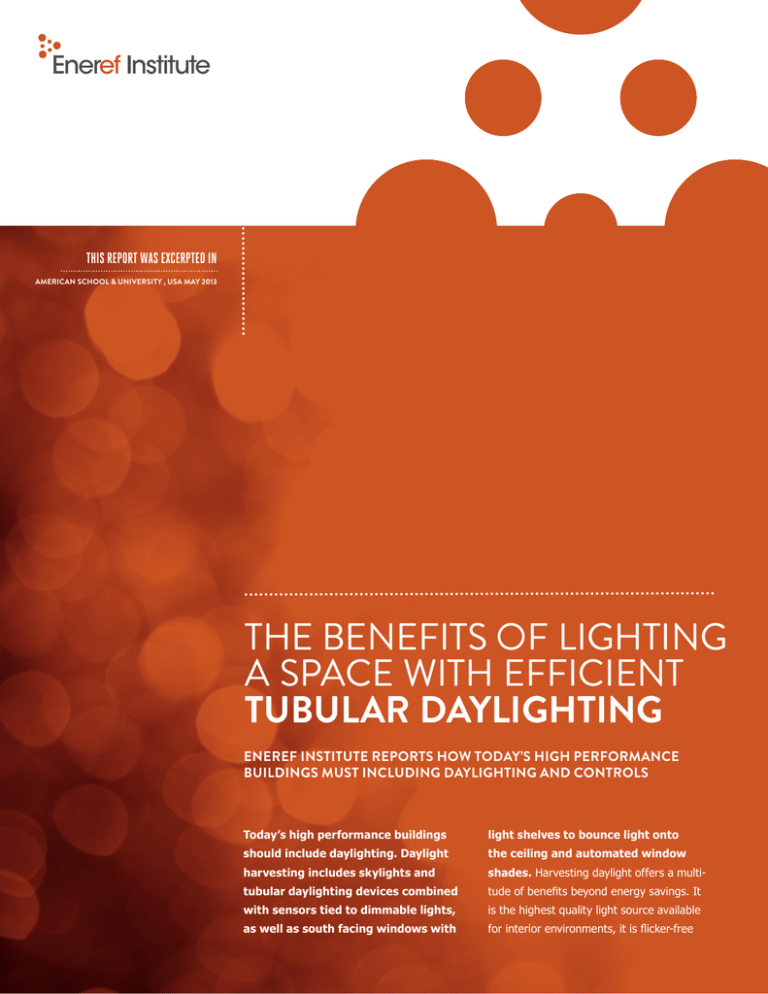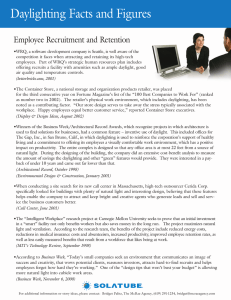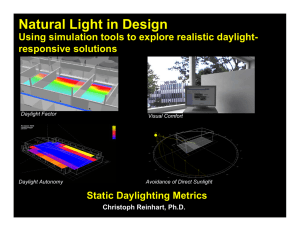
THIS REPORT WAS EXCERPTED IN
AMERICAN SCHOOL & UNIVERSITY , USA MAY 2013
THE BENEFITS OF LIGHTING
A SPACE WITH EFFICIENT
TUBULAR DAYLIGHTING
ENEREF INSTITUTE REPORTS HOW TODAY’S HIGH PERFORMANCE
BUILDINGS MUST INCLUDING DAYLIGHTING AND CONTROLS
Today’s high performance buildings
light shelves to bounce light onto
should include daylighting. Daylight
the ceiling and automated window
harvesting includes skylights and
shades. Harvesting daylight offers a multi-
tubular daylighting devices combined
tude of benefits beyond energy savings. It
with sensors tied to dimmable lights,
is the highest quality light source available
as well as south facing windows with
for interior environments, it is flicker-free
CAPTION TITLE NEEDED
Classroom with tubular
daylighting devices.
and it provides excellent color ren-
the trend is about to change. Expect
dering and color balance. Skylights
to see more and more daylighting
and daylighting tubular devices
-- especially skylights and tubular
reduce the cost of cooling needed
daylighting devices -- specified for
to counteract the heat from electric
new construction and renovations as
lights. And daylighting is one of the
well as for lighting retrofits.
fastest greenhouse gas reducing
paybacks you can buy, because it
shrinks both energy bills and relamping maintenance costs. The fact
is, introducing daylight into buildings
provides energy savings, excellent
lighting quality and more beautiful
interior spaces.
So why don’t more buildings in the
US harvest natural daylight as a light
source? According to a forthcoming
study by Eneref Institute (eneref.org)
improving attendance.
For students, day lit rooms that offer
the right amount of light for the task
at hand improve visibility and visual
comfort, thereby enabling better
recognition and legibility. For teach-
There is also plenty of evidence that
ers, daylight can enhance learning
daylighting improves occupant pro-
activities through improved student
ductivity in both schools and offices.
moods and concentration while
Especially in learning environments,
simultaneously reducing off-task be-
skylit classrooms provide a natural
havior. And while administrators can
and stimulating space for teacher
benefit from improved student and
and student.
teaching outcomes, they can also
While studies show that poor
lighting adversely affects learning, daylighting has been proven to
expect to see a lower energy and
maintenance burden as well as better compliance with code standards.
increased student performance in
Although educational investments
math and reading scores, as well as
are paid back in ways not always
RESEARCH AND REPORTING BY ENEREF INSTITUTE™ • VISIT WWW.ENEREF.ORG • COPYRIGHT © ENEREF INSTITUTE™ • ALL RIGHTS RESERVED
measured in dollars, a combination
of daylighting and control system
provides a rapid return on investment by allowing you to keep electric lights turned off for the majority
of the school day. Obviously, to
enjoy energy savings, the electric
lights must be turned off or dimmed
when the sun is shining, which is
best done automatically by controls
that sense sunlight levels and adjust
electric light levels accordingly.
Lighting accounts for roughly one
third of electricity used by commercial or educational facilities in the
United States.
As Energy Secretary Steven Chu
says, “Energy efficiency isn’t just
low-hanging fruit; it’s fruit lying on
the ground.”
to power the light fixtures.
Already, many utilities charge much
higher rates during peak demand
daylighting works best. For example
daylight harvesting alone are sig-
a utility might charge $0.17 per kWh
nificant, which has been proven to
in the afternoon, but only $0.11 at
raise morale, increase productivity
night. The proposed SmartGrid will
of students and workers, decrease
make this more common, and thus
product defects for numerous indus-
shorten the payback period further
tries, and even increase retail sales.
for daylighting installations.
The human performance numbers
Facilities with open or drop ceilings
are perfect for daylighting, where
depending on cost of energy, systems can offer a 5 year ROI or less.
And after the payback period, it’s
like money in the bank.
With growing recognition of the
benefits of daylight, expect to see
an increased demand for daylight
lighting a space when compared to,
include skylights in their stores.
say, photovoltaic cells. Photovoltaic
Educators will spec more daylight for
(PV) panels collect sunlight to
classrooms. Office building own-
generate electricity and then the
ers now believe day lit workplaces
electricity is converted back into
increase the value of their buildings.
light by way of fluorescent or LED
The demand will increase the usage
lamps. Daylighting simply harvests
of skylights and tubular daylighting
the sunlight directly. And a well-
devices in all building types.
into the classroom. Daylighting is
about 10-times more efficient than
rooftop PV cells for lighting a room.
Put another way, skylights need only
1/10 of the roof space to produce
the same amount of light as PV panels need to generate the electricity
of daylight loss.
The human productivity gains from
harvesting. More retailers will
of the daylight captured on the roof
space interior with the least amount
periods -- at the very time when
Daylighting is especially efficient for
designed system should bring most
sun rays from the rooftop into the
in daylighting systems are important because the ROI for daylighting installations can sometimes be
a difficult sell. In fact, the human
performance gains can outweigh
the energy savings, where human
performance can be measured in
financial terms.
According to Heschong Mahone
(HGM), a leading daylighting consulting firm, studies for Pacific Gas and
Electric looked at daylighting and human productivity and found positive
results in elementary student test
scores. Their PG&E study surveyed
the performance of students of
three elementary school districts in
Seattle, Washington; Fort Collins,
Colorado; and Capistrano, California.
A well-designed system is one
Standardized test scores were used
that controls and shuts off electric
as the measure of student perfor-
lights when the sun is sufficient to
mance. According to HGM, in all
illuminate the space. It should also
three districts, and controlling for
maximize the amount of daylight
other influences on learning, those
delivered into the space without
students in classrooms with more
glare. Maximizing daylight means
daylight tested higher or progressed
bringing in the maximum amount of
faster. In a follow-on study the
RESEARCH AND REPORTING BY ENEREF INSTITUTE™ • VISIT WWW.ENEREF.ORG • COPYRIGHT © ENEREF INSTITUTE™ • ALL RIGHTS RESERVED
researchers found that students with
It looks like America has finally
the most daylighting in their class-
begun to catch on.
rooms progressed 21% faster on
math and reading tests compared to
those in classrooms with no daylight.
The fastest, easiest way to bring
daylight into an existing building is
with a skylight or tubular daylighting device (TDD). A well designed
system can capture low angle sunlight – allowing daylighting for more
hours – and uses adjustable elbows
to bypass obstructions and transport
the sun’s rays some distance typically via a 98% reflective specular
material, thereby leading the rays
through the building. Look for
systems that incorporate integrated
light controlling louvers and diffusers
to maintain optimum foot-candles.
Electric lights should include dimming control system to supplement
the natural daylight when needed.
Both skylights and tubular daylighting devices should be optically
designed to complement the LED
or fluorescent fixtures and provide
a seamless transition between light
sources.
A high performance prismatic lens
will optimize light levels and eliminate unwanted glare and hotspots
by diffusing the light. A prismatic
lens will also mitigate UV damage.
Over 50 years ago, Louis Kahn, one
of America’s greatest architects said,
“No space, architecturally, is a space
unless it has natural light.”
RESEARCH AND REPORTING BY ENEREF INSTITUTE™ • VISIT WWW.ENEREF.ORG • COPYRIGHT © ENEREF INSTITUTE™ • ALL RIGHTS RESERVED





